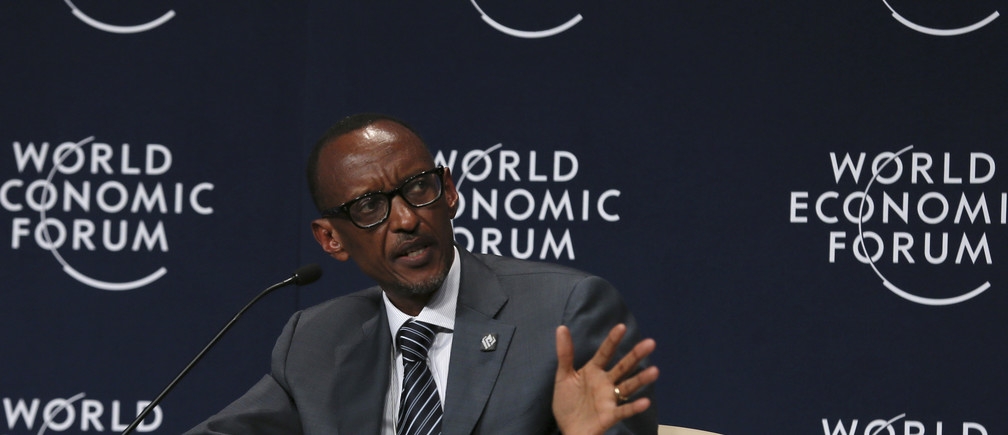Vision City, Rwanda’s largest housing project, sits on a hill overlooking the rest of Kigali. Its rows of whitewashed villas and townhouses stand out against the green landscape and shacks made of scrap metal and mud, in the slum in the valley below. Outside the main office, a mayor visiting from Ghana listens to his tour guide, an energetic young Rwandese official, detail the plans. There will be free wifi in the town square, solar-powered street lamps, a 36-meter antenna, powered by the sun to beam 4G LTE to residents, and motion censors that trigger the electricity when one walks into one of these homes.
If all goes to plan, the rest of Kigali and more of the country will look like this idyllic, tech-enabled district within the next two decades. Rwanda is on a campaign to transform its capital city of rolling hills and low-rise buildings into a so-called smart city (video) where urban living has been optimized. Already, officials like to stress how much technology is part of daily life in Rwanda, from the president’s active Twitter presence to the fact that registering a marriage, death, or birth—things that would normally require multiple forms and trips to a government office—are increasingly done online. Speeding tickets can be paid through mobile money.
The concept of the smart city first emerged in the early to mid 2000s as governments sought to digitize and become more efficient. (Some argue that it emerged earlier in the 1980s). Now, the term connotes the use of big data and technology in urban planning. It’s bandied about by large technology companies like IBM and Cisco, city officials, and property developers—the global market for smart city services could reach as much as $225.5 billion in 10 years, from an estimated $93.5 billion this year.
The idea has become even more popular in emerging economies. After the financial crisis in 2008, international property developers and technology companies have been looking to fast-growing Africa and Asia, faced with overpopulation, scarce resources, and poor infrastructure. India has pledged to build “100 smart cities ” before 2022. China says it will have more than 500 cities by the end of the year using technologies from permeable roads for absorbing water run off to facial recognition enabled payments. In Africa, where as much as a quarter of the world’s population will live by 2050, more than half of them in cities, the idea is gaining even more traction.
The continent’s smart city initiatives range from tech hubs like Ghana’s Hope City to residential and business districts like Johannesburg’s Waterfall City and Eko Atlantic, an island constructed on reclaimed land near Lagos, meant to be “Africa’s first smart city.” Nigeria is also launching a smart cities initiative with a summit in August. Addis Ababa’s recently launched what city officials are calling Africa’s first smart parking system. Twenty countries have joined a pact started by Rwanda called the “Smart Africa alliance,” to make technology a part of their national development plans. The African Union has also made smart city adoption one of the tenets of its 2063 development plan.
Still, for as popular as the idea of the smart city is, there are few examples of wholesale success around the world. Skeptics question whether these technologies increase surveillance and add to security risks as well as the influence of private companies over how cities are designed. In Africa, smart city ideas may be even more misplaced.
“If anything the ‘smart’ idea is used as a marketing tagline and quite often these ideas, if you look at the visual representations, they have absolutely nothing to do with what cities look like,” says Nancy Odendaal, an associate professor at the University of Cape Town’s School of Architecture, Planning and Geomatics. “The popular idea of the smart city has very little to do with the socioeconomics of a city,” she says.
“Too small, too disconnected”
In many ways, African cities are prime candidates for developers and smart city campaigns. The number of people living in urban areas on the continent has gone from 15% in 1960, the same proportion as Europe in the 1600s, to almost 40% today, higher than in South Asia. Of the world’s 29 megacities, those with more than 10 million people, two are in sub-Saharan Africa. By 2030, at least six of the world’s megacities will be in Africa. To deal with congestion some countries are moving their capital cities.
“Too small, too disconnected”
In many ways, African cities are prime candidates for developers and smart city campaigns. The number of people living in urban areas on the continent has gone from 15% in 1960, the same proportion as Europe in the 1600s, to almost 40% today, higher than in South Asia. Of the world’s 29 megacities, those with more than 10 million people, two are in sub-Saharan Africa. By 2030, at least six of the world’s megacities will be in Africa. To deal with congestion some countries are moving their capital cities.
Others, like Rwanda, home to the highest population density in Africa, are overhauling existing cities as well as building new ones. A few miles east of central Kigali, a special economic zone will be home to Kigali Innovation City, for tech incubators, universities, and companies both local and international. Firms based here will enjoy preferential income tax rates, tax holidays, and waived customs duties.
Critics say that Rwanda’s urban vision ignores the socioeconomic realities of the country. Despite important gains made in education, health, and rural development, of Rwandans are still living on less than $1.25 a day, an income the World Bank defines as “extreme poverty.”
In Kigali, the hub of Rwanda’s smart masterplan, as much as 80% of the population live in slums and often earn less 200,000 Rwandan francs (about $240) a month. Yet, units at Vision City, envisioned to help relieve the city’s housing shortage, start at 134.4 million francs (about $160,000) to purchase. (Planners say that affordable housing will be built in the later phases of the project.)
To make room for upgrades to the city, street hawkers have been pushed out of the city center or detained indefinitely in “rehabilitation centers.” Data is expensive and smartphones are out of reach for most Rwandese. “What’s going to happen is you have an upper-middle class with access to services, but the masses won’t have a chance to catch up,” says Henri Nyakarundi, founder of ARED, a startup that leases solar-powered kiosks with wifi and services to street vendors.
A bigger concern may be that, like automakers in the United States in the early to mid 20th century, for-profit companies will have too much influence over how African cities develop. To pull off its smart city efforts, Rwanda will need foreign investment and foreign ICT companies and developers.
Nokia is installing smart classrooms while Culligan, a US water treatment company, is building a smart water grid for Kigali, and Zipline, a US robotics company is delivering blood by drones. At a smart city conference in May during the Transform Africa summit, Rwanda signed various agreements with Inmarset, a mobile satellite communications company, Microsoft, and a Korean software developer Hancom.
“Most of them are private companies that are providing these smart services,” says Jean Philippe Nsengimana, the country’s minister of ICT and youth. “We have no concern because for [these companies] to be successful, the people need to trust them,” he says.
Africa’s poor megacities
So far, most African smart city initiatives have been underwhelming. Hope City, an ICT park outside of Accra meant to turn Ghana into the tech hub of West Africa is yet to break ground more than four years after it was announced. Kenya’s Konza City, an intended “techno polis” is 60 kilometers outside of Nairobi, where most of the city’s start ups have collected. It isn’t expected to be complete until after 2030.
One reason may be that Africa’s megacities aren’t like those in the past. In 1950, the world’s largest cities were mostly in rich countries. Now, almost all of them are in low-income countries. Instead of creating “agglomerations” of labor and productivity, these cities are just congested, with the majority of urban dwellers uneducated and unskilled (pdf), according to researchers from George Washington University and the University of Houston who found that population increases were correlated with suppressed wages in poor megacities. It’s estimated that more than 60% of people in African cities are living in slums.
“It’s not a silver bullet by any means,” says Mira Slavova, an urban studies researcher at the Gordon Institute of Business Science in South Africa. These initiatives “fail to address the fact that the majority of people on the continent are poor and often live in unpalatable conditions,” she wrote last year on the African Union’s smart city agenda. Moreover, smart city plans often focus on capitals like Kigali when most of the continent’s urbanization will come from smaller towns turning into cities, rather than migration to existing urban centers, according to Slavova.
Miscalculated smart city efforts aren’t just a problem in Africa. In Rio de Janeiro, which won the World Smart City award in 2013, an IBM-designed data center, the Centro de Operacoes, whose traffic cameras are meant to help crime primarily focuses on wealthy areas. India’s smart city push has been criticized for creating more gated neighborhoods. “Globally, show me a city that is really smart. You find some good, some helpful projects that have shown some benefits, but how smart can it get?” Slavova says.
The people in the cities themselves can be another obstacle. Jules Ntabwoba, who works with the Irembo, Rwanda’s online government services portal, says that getting Rwandese, especially in rural areas, to use the site isn’t easy. “Theres this resistance to change. ‘We are not used to this technology,’ people say,” Ntabwoba says. In some cases, opposition comes from within the government in departments that Irembo is taking online. “Some people fear technology because they fear they will be replaced,” he says.
Source: Quartz Africa




